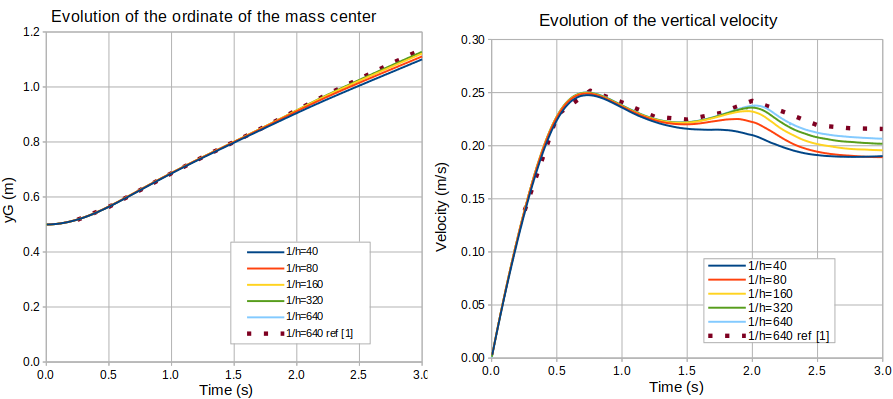Rise of a bubble with variable density using VOF-PLIC method.
Rise of a bubble with variable density using VOF-PLIC method.
This test case solves the problem of a rising bubble under gravity entrainment [1]. It consists of two immiscible fluids separated by an interface.
This problem involves the following numerical methods:
This test case aims at the validation of the conservative VOF-PLIC method [2].
The validation criteria are:
The simulations take places in a 2D box of fluid of coordinates \((0,0)\) and \((1,2)\). The bubble is centered at the position \((0.5,0.5)\) and is of radius \(0.25 m\).
The first fluid is the denser one that surrounds the bubble (noted with \(2\) as a subscript). There are two different cases:
| Case | \(\rho_1\) | \(\rho_2\) | \(\mu_1\) | \(\mu_2\) | \(\sigma\) |
|---|---|---|---|---|---|
| A | 1000 | 100 | 10 | 1 | 24.5 |
| B | 1000 | 1 | 10 | 0.1 | 1.96 |
where \(\sigma=\sigma_{1,2}\) is the surface tension coefficient between the two fluids.
The initial velocity is null in the whole domain.
We have used the same boundary conditions as in the literature [1]. The left and right boundary conditions are slip; the bottom and top boundary conditions are null velocity (wall).
The gravity is set to \(g=0.98 m.s^{-2}\) in the \(y\) direction, as in the literature. The problem is studied until \(t=3s\) with a \(0.001s\) time step to verify the CFL.
In order to evaluate mass loss \( \varepsilon \) during the simulation, we compute the difference between the volume fraction of fluid at initial time and at time T.
\begin{align} \varepsilon = \sum \limits^{N^2}_{i=1}f_i - \sum \limits^{N^2}_{i=1} f_i^0 \end{align}
In the .nts files : CASE variable is used to choose between the two cases and the h variable defines cell size in all directions.
The following figure shows comparison of the volume fraction isocontour at time t=3s between 1/40 and 1/320 mesh size.

In order to complete the validation we compare in the following plots the reference evolution of the center of mass position and velocity presented in [2], with the computed evolution.

Next table shows the mass conservation results:
| Grid size h | \( \varepsilon \) |
|---|---|
| 1/40 | \( 4.44 \times 10^{-16} \) |
| 1/80 | \( 1.33 \times 10^{-15} \) |
| 1/160 | \( 1.42 \times 10^{-14} \) |
| 1/320 | \( 4.44 \times 10^{-16} \) |
The following figure shows comparison of the volume fraction isocontour at time t=3s between 1/40 and 1/320 mesh size.

In order to complete the validation we compare in the following plots the reference evolution of the center of mass position and velocity presented in [2], with the computed evolution.

Next table shows the mass conservation results:
| Grid size h | \( \varepsilon \) |
|---|---|
| 1/40 | \( 1.78 \times 10^{-15} \) |
| 1/80 | \( 8.88 \times 10^{-16} \) |
| 1/160 | \( -4.44 \times 10^{-16} \) |
| 1/320 | \( 2.26 \times 10^{-14} \) |
| 1/640 | \( 2.66 \times 10^{-15} \) |
[1] S. Hysing, S. Turek, D. Kuzmin, N. Parolini, E. Burman, S. Ganesan, L. Tobiska, Quantitative benchmark computations of two-dimensional bubble dynamics, International Journal for Numerical Methods in Fluids 60 (11) (2009) 1259–1288.
[2] G.D. Weymouth Conservative Volume-of-Fluid method for free surface simulations on Cartesian-grids, Journal of Computational Physics 229 (2010) 2853-2865.